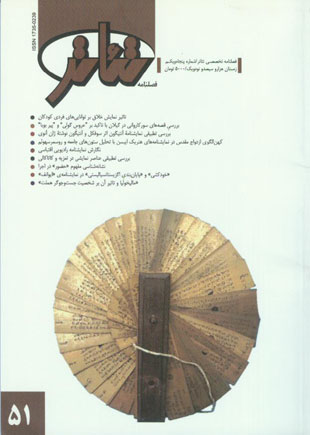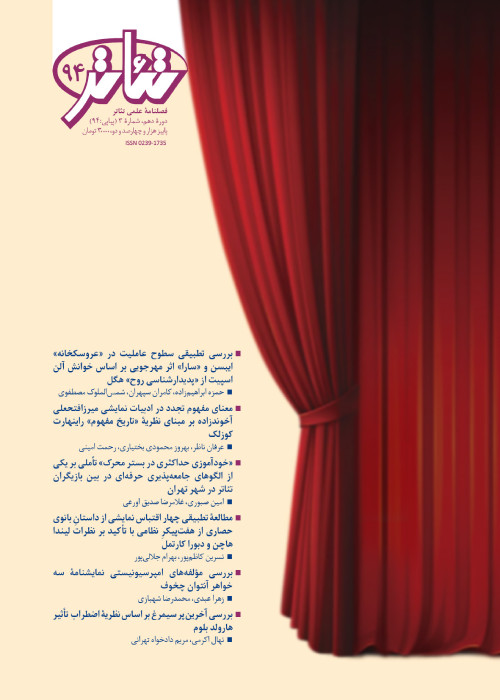فهرست مطالب

نشریه تئاتر
سال یکم شماره 51 (زمستان 1391)
- 186 صفحه، بهای روی جلد: 50,000ريال
- تاریخ انتشار: 1392/10/17
- تعداد عناوین: 10
-
صفحه 6
-
بررسی قصه های سور کاروانی در گیلان / با تاکید بر عروس گولی و پیر بوباصفحه 19
-
کهن الگوی ازدواج مقس در نمایشنامه های هنریک ایبسن / با تحلیل ستون های جامعه و روسمر سهولمصفحه 49
-
صفحه 77
-
صفحه 119
-
Page 7This research implemented with the help of “Art and Creative players” group’s instructors in 8 towns of Kerman Province. As the first step the instructors of these 8 towns in Kerman became familiar with the creative play that is a training play and is planned for empowering the children. The next step was holding workshops in these 8 towns by trained instructors for training other regional instructors. Because the responsible administration could not pay the regional instructors wage for the second course of workshops, inevitably these workshops held by instructors in Kerman. Evaluating ability range of participants in the workshops in the beginning and end of the courses was the last step of this section that is implemented during one year with the population of 95 participants in workshops. Instructors investigated the influence of creative plays by 17 indicators of individual abilities using questionnaire and interview. Results evaluated by statistical analysis. The result was development of all ability; but evaluating the range of these developments shows that creative play exercises was more effective in some abilities.Keywords: Creative play, Individual abilities of children, Creative players
-
Page 19In the present study Badger Festive shows in Gilan - carnival – and its fictional elements investigated by some subspecies carnival dramatic elements, that has taken important steps in recognition and classification of it by this investigation. Although many of these Secular ritualistic performances, in Iran or even the world-not only in Gilan- have poor narrative structure, but still some of them has a kind of theatrical elements as "Aroos Gouley" and "Pir Boba" In these carnivals better characters, dialogues and stories are used and along with the other festive and New Year ritual shows have advance help in theatrical act.Keywords: Theater, Drama, Carnival, Gilan, Aroos Gouley, Pir Boba
-
Page 35This paper aims to investigate the comparative effects of two plays Antigone by Sophocle and Antigone written by Jean Anouilh according to the existing dramatic elements in both works and also interactive pattern Greimas find the sharing points and Distinctions between two texts. As Dr. Farhad Nazerzade Kermani said: The art language, or artistic expression like any language has “structure” (Constituent elements: words) and “Aesthetic plan” (grammar). Structure of every play can be placed in two large cases: compatible and content structure. Compatible is plan, map and program; and content includes Intellectual, Meaning and work’s root of thought. This paper by investigating Antigone Anouilh and Antigone Sophocle from story map point of view, structure of story map (including familiarityoriented and Revolutionize ontime), turning, removing turns, conflict and crisis, climax, peripatetic and closure, and time and place aims to find out Common points and distinctions of these two texts. A. J. Greimas is one of Constructivists that worked based on Prop. Greimas by study on semantics and structures of meaning could discover “The theory Interaction model”. He therefore proposed six functions (sender, receiver, dealer, helper, subject and object) and according them proposed a pattern. Analysis in This article is based on that pattern.Keywords: Antigone, Sophocle, Zhananvy, playing mains, interactive pattern Greimas
-
Page 49One of the troubles of theatre critics is Recognition of tragedy elements and structure in tragedies. This essay tries to investigate the critical analysis of Ibsen’s modern tragedies based on methods and approaches of archetypal criticism. It seems that evaluation of family and marriage in Ibsen’s play is a road to recognition problems of Ibsen’s tragedy elements; because the main acts of Ibsen’s dramas are on family bases. So by discovering love triangle in his plays, with archetypal criticism, this essay tries to investigate the playwright’s criterions in recognizing the love triangle and discover the reason of tragic action in choosing the hero. In spite of contradiction illusion between realism and myth, this essay recognizes patterns and criterions of holy marriage in Scandinavian myths and patterns and criterions of pagan marriages in modern and Christianity marriage and adapting that with love triangles of Ibsen’s plays and shows the dialectic of pagan and Christianity of Ibsen’s plays and by that could analyzes the structural elements in these two plays. Elements of Ibsen’s play in Pillars of society and Rosmersholm, with that dialectic.Keywords: Archetype, Scandinavian Myths, Christianity, Modernism, Tragedy, Love triangle
-
Page 77Changing the fictional literature to dramatic literature is one of the most important styles of writing in different Medias. Radio, as a powerful media in today’s world has special status among audiences. The radio drama is one of the radio programs which could make the programmers short and long term aims. The thing that involves the author’s mind is the question of changing narrative functions in Iranian and foreign short stories for radio dramas. This article tries to find the differences and common structural points between radio drama and short story by describing and analyzing methods to help playwrights in writing adapted dramas for a media as radio. The resulted point of this article is the interpreting and comparing the narrative functions of short story and radio drama.Keywords: narrative, quotation, radio drama, short story
-
Page 101Iran and India, are the Asian countries have a lot in common.Top of Form Bottom of Form Rich culture and religious beliefs are the most common parts of these countries, but with many differences especially in the ritual and religious aspects.Bottom of Form It is obvious that created theaters on the foundation of these two cultures have the common elements but also they have many differences too. The main point emphasized in this article is the investigation on these two traditional theaters both Tazzie in Iran and Katakaly in India to find common elements in these two theaters and anal ysis of content and structural elements. In this way, the only way to collect data is used in library. This study that compares two views Katakaly of India and Tazzie of Iran according to the cultural convergence of context and Asian geographical situation of these two countries the dramatic elements are used symbolically. So the most common structural elements of these two are symbolic. In terms of content, these two have a common origin that all of them have root in East theaters generally and a view to human and nature, and environmental and social role in the community.Keywords: Drama, Iran, India, Tazzie, Katakali, Dramatic elements, East
-
Page 119Presence is taken to be a structural entity, the presence, the confrontation of all signifying systems the signifying systems, created both by production and reception (the spectators). The study of “presence” as a semiotic phenomenon suggests that the meaning of “presence”, as a sign, is generally understood in relation to other concerns, and all lie beyond the province of signification. Means are not static symbols, but exist only in a suspended animation or doubt. Then presence should not be seen as something fixed, but as the subjects of a constantly shifting interplay between theatrical signification and the context in which a performance take place. It is the very potential of theatre enable us to reflect upon and question the construction of “reality” in the contemporary world. The purpose of this article is to explicate some common elements relevant to performance [text, space, actor, language, object, audience] and the semiotics of “presence”.Keywords: presence
-
Page 145Many contemporary theorists of Drama’s world believe that the root of most main schools of dramatic literature of 21th century, like absurd and existentialism, should be search in Chekhov’s drama. They think that many of these schools are indebted to traditions of Chekhov drama. In this essay with use of an analytical approach we are describing that suicide of Ivanov, main character of Chekhov first full length drama, is not a sudden death rather it’s arising from an “existential fear” that is one of the basic concepts of existentialism school. As suicide is the last action of the play and converge all events of the play has an important influence in forming and making the ending. Although Chekhov writes decades before the rise of existentialism school but the original ideas of his plays are very similar to many existentialist philosophers and writers, especially Heidegger, Camus and Sartre. So to clarify and explain questions and answers of this essay, we used their views.Keywords: suicide, Ivanov, Ending, Existentialism
-
Page 163Hamlet is the one of the most famous characters in the drama who many theorists have commented about him. One of those characteristics which is significant is melancholy. Melancholia is a disease in which a person is suffering from certain mental attitudes is not shown in his regular behaviors. The question of this article is that: How his melancholic behaviors have influence on his explorer character and how it change his way of detection. Prince Hamlet who is a young intellectual, attacking melancholy his character changes and do some works that is not expected. In this essay which is used by analytical approach we answer this question.Keywords: Melancholia, Hamlet, Search, Detective character


